ABSTRACT
In the present work, the effect of thermal (pasteurization) and nonthermal (thermosonication) treatments on the variations in physico-chemical, antioxidant activity, total phenols, total flavonoids, microbial populations, and sensory attributes of pomelo juice was studied. In thermosonication, processing parameters like treatment temperatures (30, 40, and 50 ± 2°C), treatment time (15, 30, 45, and 60 min), and sonication frequencies (33 and 44 kHz) were varied. TSS and TA of thermosonicated samples was not varied in comparison with control samples and minor differences in pH were observed. Significant improvements in DPPH activity, total phenols, and flavonoids were observed in both sonication frequencies and the results significantly varied as the treatment temperature was increased. From the research study, it can be inferred that juice samples processed at 50°C in the sonication frequency of 44 kHz produced maximum levels of total phenols, flavonoids, and DPPH activity.
Introduction
Fruits and vegetables are very important for a healthy diet as they constituted high quantities of dietary fiber, vitamins, minerals, electrolytes, and phytochemicals (Slavin and Lloyd, Citation2012). Regular consumption of fruits and vegetables may improve the health status of consumers. The WHO and FAO reports recommend the adults to take at least five servings of fruits and vegetables per day (WHO, Citation2003). It is confirmed by various research works that a daily diet comprised of fruit and vegetables could reduce the risk of chronic diseases such as cardiovascular diseases, hypercholesterolemia, blood pressure, osteoporosis, several cancers, and respiratory problems (Adebawo et al., Citation2006).
Pomelo (Citrus maxima), also known as shaddock or Chinese grapefruit, that belongs to the Rutaceae family. It is commonly classified as white pomelo and pink pomelo (Cheong et al., Citation2012). They are consumed as raw fruits and have a sweet, moderately acidic taste with a little bitterness. Pomelo is a good source of various bioactive constituents including, ascorbic acid, phenolic compounds, flavonoids, coumarins, pectin, and dietary fibers (Youseif et al., Citation2014). These flavonoids present in the citrus fruits have several biological activities including antioxidant, anti-inflammatory, antianxiety, antibacterial, antidiabetic, and anticancer activity (Sidana et al., Citation2013).
Processing of juices is essential in order to increase the storage life for a longer time period. Generally, juices are processed through thermal processing techniques (Jabbar et al., Citation2014) to assure the safety of the juices by preventing the action of enzymes and microorganisms (Abid et al., Citation2014). However, thermally processed juices exhibited significant losses in nutrient levels, color, and flavor which has been shown by previously published reports (Santhirasegaram et al., Citation2013). Therefore, processing technologies for juices should be preferred that will not show any or less effects on the quality.
In the last few years, various nonthermal processing methods were established to meet the demands of the consumers who were looking for fresh-like processed fruit juices (Jayathunge et al., Citation2017). In this context, nonthermal methods such as high-pressure processing, pulse electric fields, ionizing radiations, and ultrasonication (Kwaw et al., Citation2018; Nayak et al., Citation2018) were studied on different juices for minimizing the losses in fruit juice quality.
Ultrasonication is one of the non-thermal techniques which can be applied for the treatment of juices in the place of thermal processing methods. Commonly, fruit juices were treated in the ultrasonication frequencies varied from 20 to 100 kHz at 10–1,000 W/cm2 (Delgado-Povedano and De Castro, Citation2015). The principle of ultrasonication involves the formation of bubble cavitations in liquids due to pressure differences, which results in the breakdown of microbubbles and an increase in the temperature and pressure. Alternatively, the increase in temperature produces a thermal effect that improves the quality of fruit juices (Zinoviadou et al., Citation2015). But, the application of ultrasound may not be preferred to reduce the growth of some microorganisms in fruit juices, when it is applied at temperatures near to 25°C. So, the effectiveness of ultrasonication can be increased when it applied with moderate heat as reported by several researchers and it is known as thermosonication (Anaya-Esparza et al., Citation2017). Various researchers have displayed the preservative effect of ultrasonication on fruit juices including guava juice (Campoli et al., Citation2018), kaji lemon juice (Kesavan et al., Citation2019), star fruit juice (Nayak et al., Citation2018), and strawberry juice (Wang et al., Citation2019b).
The major objective of the present study was to investigate the influence of thermosonication on the quality characteristics of pomelo fruit (Citrus maxima) juice in comparison to fresh and pasteurized juices.
Materials and Methods
Materials
Fresh pomelo (Citrus maxima) fruits at the full maturity stage were supplied from wholesalers in Kokrjahr, Assam. Before processing, fruits of uniform size, shape, and weight were selected and defective fruits were discarded. Fruits were washed thoroughly and non-edible portions were removed.
Chemicals used in the analysis of juices were purchased from Sigma Aldrich (Bengaluru, India). Media for enumerating microbial populations were supplied by MERCK (Darmstadt, Germany).
Thermal and Non-thermal Processing of Pomelo Juice
The edible portion of pomelo juice was pulped in a grinder. After pulping, juices were filtered using a muslin cloth before labeling the juices as fresh or control, pasteurization, and thermosonication. Treatment of juices was carried out on the same day of juice extraction.
Thermal processing (pasteurization) of juice was performed using a lab-scale pasteurizer at 90°C for 60 s. After thermal treatment, juice samples were transferred to an ice box for cooling (Santhirasegaram et al., Citation2013).
Ultrasonicator bath (GT Sonic, Guangdong, China) was used for accomplishing the nonthermal treatment (thermosonication) of pomelo juices (Nayak et al., Citation2018). Thermosonication treatments were conducted under different treatment times (15, 30, 45, and 60 min) at different treatment temperatures (30, 40, and 50 ± 2°C). Juices were treated at two frequencies 33 and 44 kHz. Dark conditions were maintained in order to avoid the effect of light on juice processing. For each treatment, 50 ml of pomelo juice samples were used. After each treatment, juice samples were transferred to sterilized bottles and kept in a refrigerator (4 ± 1°C) till further analysis.
Physico-chemical Analysis
A digital pH meter (OAKTON pH Testr30, USA) was used to know the pH of the juice samples. About 10 ml of juice sample was taken and mixed thoroughly in a magnetic stirrer and pH value was recorded.
The amounts of total soluble solids (TSS) present in pomelo juice were checked by using a refractometer (Master −3 m ATAGO, Tokyo) according to the method followed by Nayak et al. (Citation2020a).
AOAC (Citation1999) method was followed to determine the titratable acidity of the pomelo juices and the results were given as a citric acid percentage (%).
Cloudiness and Browning Index
The method followed in the research work of Cervantes-Elizarrarás et al. (Citation2017) was utilized for the determination of cloudiness and browning value of pomelo juice samples (fresh and treated).
DPPH Scavenging Activity
The antioxidant activity of the juice samples was calculated by using DPPH-free radical assay (Radha Krishnan et al., Citation2015). The findings of the experiments were presented as percentage inhibition of DPPH radicals.
Total Phenolic Contents
The total phenol level in the fruit juices (treated and untreated) was computed by using the method followed by Krishnan et al. (Citation2020). TPC levels were given as gallic acid equivalents (GAE) per ml of juice sample.
Total Flavonoid Contents
Total flavonoid contents of pomelo juice samples were estimated using the method given in the work of Nayak et al. (Citation2018) and the TFC levels were stated as milligram of catechin equivalents (CE) per ml of juice sample.
Ascorbic Acid Content
Pomelo juices were analyzed for their ascorbic acid levels by using the Iodine titration method (Behera et al., Citation2017). The ascorbic acid content of juices was presented as mg of ascorbic acid per 100 ml of juice sample.
Microbial Analysis
The major aim of any food processing method was to ensure the safer delivery of the food products to consumers. To assure the microbial safety of the juice samples, total plate counts, yeast, and mold counts were checked (Nayak et al., Citation2017). Total plate counts of the samples were assessed by spread plating the juice samples in total plate count agar and keeping it in the incubator maintained at 37 ± 1°C for 48 hr. Yeast and mold counts were examined by spread plating the juice samples in potato dextrose agar (after pH adjustment to 3.5 by 10% tartaric acid). The plates were kept in the incubator for 5 days and the temperature was maintained at 25 ± 1°C, till enumeration of microbial populations.
Sensory Analysis
The sensory properties (taste, odor) of processed and unprocessed pomelo juice samples were examined by a group of 25 members (untrained). During the sensory trails, fresh juice samples were used as a reference material. A rating system of 0–9 was followed during the assessment of fruit juices. Sensory scores for the juice samples have been defined by the following scores: excellent, 9; very good, 8; good, 7; acceptable, 6; poor, <6. A sensory rating of 6 was considered as the lower acceptability limit (Nayak et al., Citation2020b).
Statistical Analysis
All the experiments were conducted in triplicates. The experimental results were shown for both Sonication 33 kHz and 44 kHz. SPPS 16.0 software (SPSS Inc., Chicago, IL) was used to scrutinize the data by ANOVA at a significant level of p < .05. The least significant difference method was applied using R Software version 4.0.1 (New Delhi, India) to examine the differences in the mean values and presented in , . In , it can be observed that treatments with the same letter are not significantly different. For instance, the treatment of Ascorbic and DPPH is in the same groups means not significantly different whereas TPC and TFC are significantly different.
Table 1. (a) Analysis of variance table (Sonication-33 kHz)
Table 2. LSD test statistics
Table 3. LSD treatment comparisons
Results and Discussion
Impact of Thermosonication on pH, TSS, and TA
In the present study, the juice extracted from pomelo fruit was treated through thermal and nonthermal method (thermosonication) and the quality parameters of the processed juices were compared with fresh juice. One of the objectives of the work was to maintain the stability of pomelo juice in refrigerated conditions without affecting its sensorial properties. pH, total soluble solids (TSS), and titratable acidity (TA) were some of the properties which may influence the sensorial attributes of juices.
pH of the fresh juice was significantly varied from the pasteurized and thermosonicated juices and the results of the work were produced in . pH values were obtained as 3.58 ± 0.08 and 3.34 ± 0.06 for control and pasteurized juices. Thermosonicated juices showed minor variations in the pH and the values were obtained in the range of 3.16 ± 0.09 and 3.29 ± 0.06. The decrease in the pH of thermosonicated juices may be the result of the production of new chemical compounds (flavonoids, limonoid, coumarins, carotenoids) in pomelo juice due to the effect of ultrasonication. As this technology stimulates chemical reactions in an aqueous environment and pomelo fruit is also constituted with more water some new compounds may be produced during thermosonication (Martínez-Flores et al., Citation2015). Similar findings were also reported by Bermúdez-Aguirre and Barbosa-Cánovas (Citation2012) on the sonication of pineapple, cranberry, and grape juices.
Table 4. Effects of pasteurization and ultrasonication (33 kHz) on the quality characteristics of Pomelo juice
Table 5. Effects of pasteurization and ultrasonication (44 kHz) on the quality characteristics of Pomelo juice
The total soluble solids (TSS) of treated and untreated juices did not display any significant variations and the TSS of all samples was noted as 10.00 ± 0.10 °Brix (). The results of our work were similar to previously published research studies, where ultrasonication did not produce any changes in TSS of the juice samples (Nayak et al., Citation2017; Citation2018; Abid et al., Citation2014).
Titratable acidity (TA) of pomelo juices varied significantly after thermal and non-thermal treatments and the TA values of juices after different treatments were given in . Fresh juice showed a higher TA value in comparison to pasteurized and sonicated juice samples and it was obtained as 1.57 ± 0.03%. Pasteurized pomelo juice showed a lower TA value (p < .05) among the other samples and it was observed as 1.06 ± 0.02%. Thermosonicated juice samples did not show much variation on their TA value as seen from the data given in . TA values of the thermosonicated juices were varied between 1.30 ± 0.03 and 1.49 ± 0.03%. The minor changes in the TA values between fresh and thermosonicated juices may be attributed to the energy levels at which sonication experiments were performed may not be enough to alter the chemical structure of some larger molecules as stated by Ordóñez-Santos et al. (Citation2017). Similar results were also reported earlier in the research studies of Abid et al. (Citation2014), Nayak et al., Citation2017, and Nayak et al. (Citation2018). Overall, thermosonication process did not show any significant effects on pH, TSS, and TA.
Impact of Thermosonication on Cloudiness and Browning Index
Cloudiness of the juices is one of the factors which affects the flavor and color of fruit juices and it has been associated with compounds like cellulose, hemicellulose, pectin, protein, etc. (Aadil et al., Citation2013). Cloud value of fresh and thermally treated juice samples did not show any significant (p < .05) variations and it was noted as 0.575 ± 0.019 and 0.553 ± 0.016, respectively (). The cloudiness value of thermosonicated juices was significantly (p < .05) higher than the fresh and pasteurized samples. The cloudiness values after thermosonication treatments were found to be in the range of 0.888 ± 0.023 to 1.561 ± 0.025. It was observed that the frequency, treatment time, and temperature of the sonication process had a significant role in increasing the cloudiness of the juice samples. The increase in the cloudiness of juices may be associated with the high-pressure gradient generated by cavitation during the ultrasound process which might be involved in the breakdown of macromolecules into smaller molecules. Sonication treatments also result in the homogenization of juices and the breakdown of larger molecules. It also increases the number of suspended molecules and decreases the space between the molecules by the expansion of the surface area and thus enhances the cloudiness of the juices (Aadil et al., Citation2015).
Browning index of treated (pasteurized and thermosonicated) as well as untreated juice samples were presented in . From the tables, it can be seen that the browning index of treated samples varied significantly (p < .05) from the fresh pomelo juice. The browning index of control and thermally treated samples was observed as 0.114 ± 0.009 and 0.199 ± 0.011. Thermosonicated samples registered the browning index value from 0.116 ± 0.006 to 0.277 ± 0.012. The increase in the browning index value of treated samples might be due to maillard reactions as well as the disintegration of coloring pigments during thermosonication treatments. The results of our study were similar to the findings reported by Ruiz-De Anda et al. (Citation2019) and Aadil et al. (Citation2013).
Impact of Thermosonication on DPPH Scavenging Activity
DPPH assay has been performed widely, in order to determine the antioxidant capacity of the fruit juices. In this assay, the hydrogen transferring capacity of the antioxidants to the stable-free radicals (DPPH) that formulate diphenyl picrylhydrazine was calculated (Santhirasegaram et al., Citation2013). Comparatively, pasteurized juices showed lower DPPH scavenging activity () than the fresh pomelo juices and the values are obtained as 32.75 ± 1.19 and 44.30 ± 1.53, respectively. During thermosonication, juices treated at 44 kHz showed higher antioxidant activity () than the fresh juices as well as the juices thermosonicated at 33 kHz.
Figure 1. (a) Effects of pasteurization and ultrasonication (33 kHz) on the antioxidant capacity (DPPH activity) of Pomelo juice
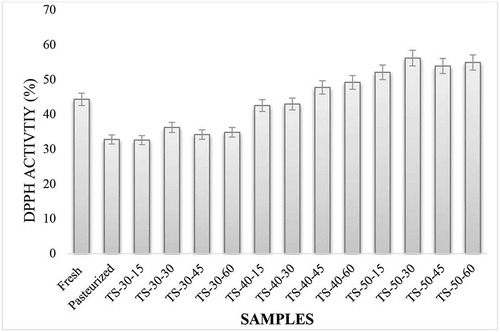
Figure 1b. (b) Effects of pasteurization and ultrasonication (33 kHz) on total phenolic content (TPC) of Pomelo juice
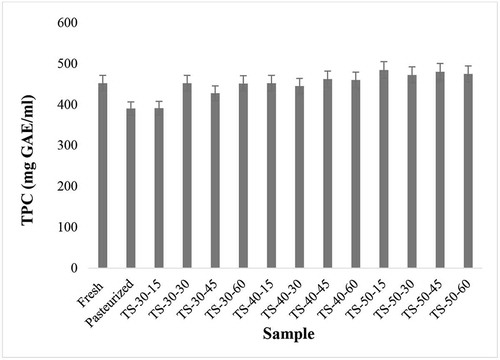
Figure 1c. (c) Effects of pasteurization and ultrasonication (33 kHz) on total flavonoid content (TFC) of Pomelo juice
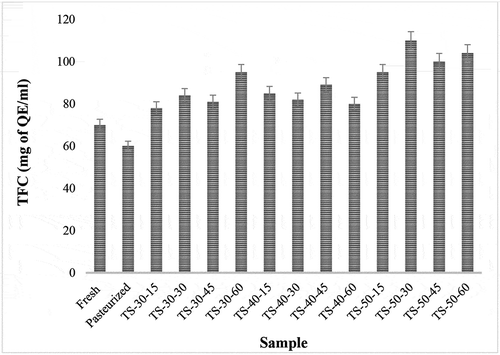
Figure 1d. (d) Effects of pasteurization and ultrasonication (33 kHz) on ascorbic acid levels of Pomelo juice
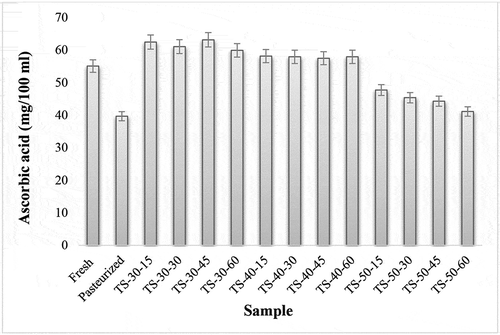
Figure 1e. (e) Effects of pasteurization and ultrasonication (33 kHz) on yeast and mold counts of Pomelo juice
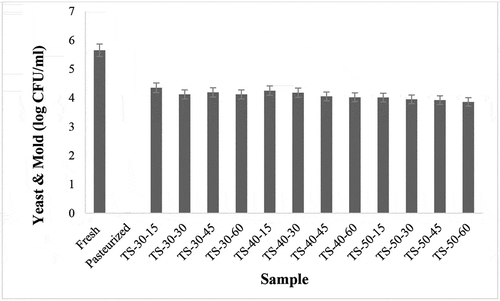
Figure 1f. (f) Effects of pasteurization and ultrasonication (33 kHz) on total plate counts of Pomelo juice
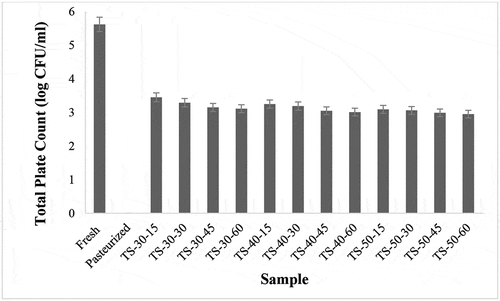
Figure 2. (a) Effects of pasteurization and ultrasonication (44 kHz) on the antioxidant capacity (DPPH activity) of Pomelo juice
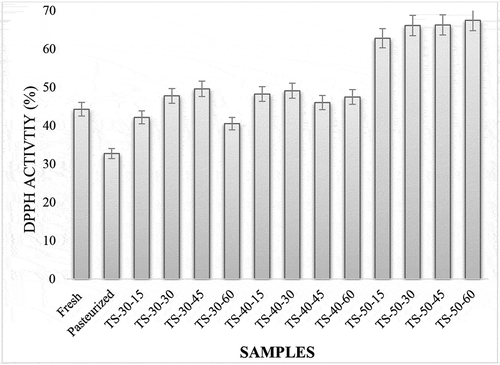
Figure 2b. (b) Effects of pasteurization and ultrasonication (44 kHz) on total phenolic content (TPC) of Pomelo juice
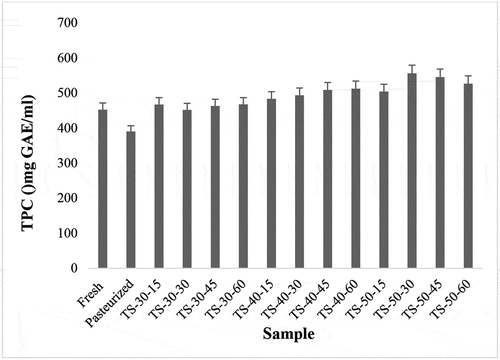
Figure 2. (c) Effects of pasteurization and ultrasonication (44 kHz) on total flavonoid content (TFC) of Pomelo juice
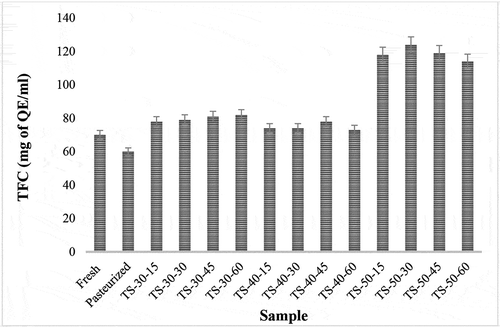
Figure 2d. (d) Effects of pasteurization and ultrasonication (44 kHz) on ascorbic acid levels of Pomelo juice

Figure 2e. (e) Effects of pasteurization and ultrasonication (44 kHz) on yeast and mold counts of Pomelo juice
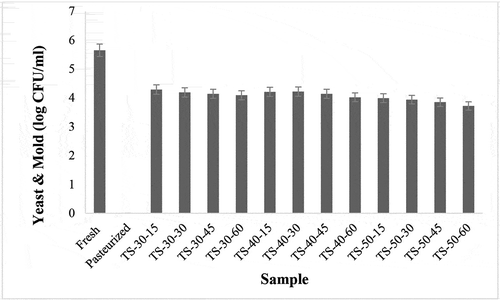
Figure 2f. (f) Effects of pasteurization and ultrasonication (44 kHz) on total plate counts of Pomelo juice
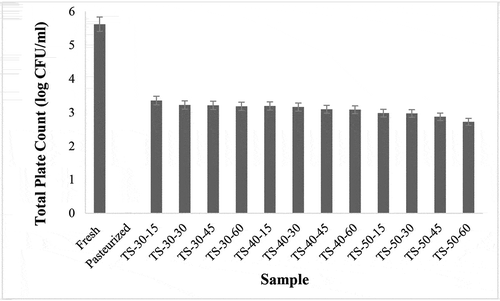
Thermosonicated juices displayed the highest antioxidant activity of 67.51 ± 2.24% which were sonicated at 44 kHz for 60 min at 50°C and it was almost 50% more than the fresh juices. The increase in the antioxidant activity of thermosonicated juices might be ascribed to the increase in several polyphenolic compounds that were released due to the cavitations created during the process which influenced the extraction and availability of these compounds (Abid et al., Citation2013). In the earlier studies, the increase in DPPH activities of different juices like apple juices (Abid et al., Citation2013), star fruit juices (Nayak et al., Citation2018), and kiwi fruit juice (Wang et al., Citation2019a) were reported due to the application of ultrasonication on juices which supports our findings. It can also be understood that the antioxidant activity of juices increases as the polyphenolic compound level increases. The antioxidant compounds play a potent role in the prevention of several diseases that are related to oxidative stresses (Abid et al., Citation2013).
Impact of Thermosonication on Total Phenols
The experimental results from the total phenolic content of treated and untreated pomelo juices were given in . From the figures, it can be seen that the phenolic content of fresh juice was higher than the pasteurized juices. Total phenol levels of fresh and pasteurized juices were calculated as 452.41 ± 16.51 and 390.11 ± 13.26 mg GAE/ml. It can be mentioned that thermosonication has improved the total phenol levels significantly (p < .05) in both frequencies (33 and 44 kHz). The highest levels of total phenols of juices processed at 33 and 44 kHz were recorded as 484.32 ± 17.08 and 555.16 ± 18.37 mg GAE/ml. Generally, the phenolic compounds are present in the bound form (with pectin, cellulose, etc.) and in soluble form (Nadeem, et al., Citation2018). Accordingly, the phenolic compounds existing in the bound form may not be estimated during the analysis of fresh juice. The upsurge in TPC is also attributed to the cavitation effect on the cell walls which promotes the discharge of phenolic compounds through cell wall breakage (Ashokkumar et al., Citation2008). The increase in TPC after thermosonication may also be favored by the exclusion of entrapped oxygen molecules from the pomelo juice as reported by Santhirasegaram et al. (Citation2013).
The treatment temperature also had a significant (p < .05) impact on total phenols (in both frequencies) and it can be seen that the TPC of pomelo juices was increased as the treatment temperature increased. The differences in TPC levels of the juices processed between 30°C and 50°C were estimated as 10% and 15% at 33 and 44 kHz, respectively. But treatment time did not show any significant influence over the TPC in all treatments.
Impact of Thermosonication on Total Flavonoids
The comparison of total flavonoids in processed and unprocessed juices was depicted in . Fresh and pasteurized juices did not show many variations in total flavonoid levels (TFC) and it was obtained as 70.04 ± 3.35 and 60.08 ± ± 2.46 mg of QAE/ml for fresh and pasteurized pomelo juices, respectively. As seen from , a significant increase (p < .05) in TFC was detected in all thermosonicated samples as related to the pasteurized samples. The increase in TFC thermosonicated pomelo juices displayed a similar trend as like TPC. Juices treated at 44 kHz showed higher TFC levels in comparison with juices treated at 33 kHz. The TFC values were ranged between 77.81 ± 2.83–110.17 ± 3.29 and 77.96 ± 3.93–124.16 ± 4.59 mg of QAE/ml, respectively, for 33 kHz and 44 kHz. The significant rise in the TFC of thermosonicated juices was ascribed to the release of more flavonoid compounds as a result of cell wall collapse due to the cavitation effect created by ultrasound waves (Nadeem et al., Citation2018).
The increase in TFC of pomelo juices could be advantageous to the consumers as it helps in maintaining the good health of the people (Wang et al., Citation2019a). The increase in total flavonoids after thermosonicaion was almost 30% and 45% as compared to fresh juice in the frequencies of 33 and 44 kHz. Here, treatment temperature also played a major role in improving the TFC of pomelo juices as the process temperature was increased and it has been seen in both thermosonication frequencies (Nayak et al., Citation2018).
Impact of Thermosonication on Ascorbic Acid
Ascorbic acid contents of treated and untreated juices were presented in . From the results, it can be perceived that pasteurized juices displayed lower ascorbic acid levels in comparison to other samples (fresh and thermosonicated) and it was obtained as 39.66 ± 1.26 mg/100 ml. Fresh juice samples exhibited ascorbic acid content of 55.07 ± 1.41 mg/100 ml which was slightly lower than the thermosonicated samples treated at 30°C.
In the thermosonication experiments, treatment temperature played an important role over the ascorbic acid levels, where it significantly (p < .05) reduced the ascorbic acid contents as the temperature increased from 30 to 50°C. The ascorbic acid levels of thermosonicated samples varied from 41.11 ± 1.28 to 63.12 ± 2.09 mg/100 ml. From the previous research works, it was stated that the factors such as light, high temperatures, and pressures may influence the ascorbic acid levels and they may decrease it through aerobic and anaerobic reactions (Wang et al., Citation2019a). As stated by Santhirasegaram et al. (Citation2013), free radicals that were created through sonochemical reactions may also be a factor in reducing the ascorbic acid levels. Similar results were reported by Santhirasegaram et al. (Citation2013) and Wang et al. (Citation2019a) in their research studies on mango juice and kiwi fruit juice with respect to the reduction in ascorbic acid levels during sonication experiments.
Impact of Thermosonication on Microbial Populations
Various nutrients present in the fruit juices make it as a very good resource for the multiplication of microbes, a place for foodborne pathogens and associated risks (Tomadoni et al., Citation2017). Microbial populations (total plate count and yeast and mold counts) in treated and untreated samples were given in . Total plate count, yeast, and mold counts of fresh samples were observed as 5.62 ± 0.023 and 5.65 ± 0.019 log CFU/ml, respectively. Pasteurized juices displayed excellent microbial quality as the complete elimination of microbes was observed from the analysis. Application of high temperatures during pasteurization may destroy organic substances (DNA, RNA, and proteins) that are needed for the proper functioning of microbes, thus results in cell lysis (Santhirasegaram et al., Citation2015a). Similar results for the complete inactivation of juices treated through thermal processing were reported by (Santhirasegaram et al., Citation2013, Santhirasegaram et al., ; Tomadoni et al., Citation2017).
Thermosonication experiments exhibited significant (p < .05) reduction in total plate count, yeast, and mold counts with respect to the control (fresh juice) samples. The decrease in the microbial population was better as the treatment time and temperature increased. The reduction in microbial counts may be attributed to the increase in temperature and pressure of liquid due to thermosonication (Saeeduddin et al., Citation2016). It was also reported that the inhibitory effect of thermosonication on microbial population may be due to the water cavitation and the production of free radicals. Free radicals such as H+, O.2, OH., HOO. were produced due to the sonolysis of water molecules occurring in juices. These free radicals were responsible for causing the oxidative damage, disruption of microbial cell walls and inhibition of the growth of microbes by inactivating the enzyme activity of mitochondria (Tomadoni et al., Citation2017).
Impact of Thermosonication on Sensory Attributes
Sensory assessment of raw, pasteurized, and thermosonicated juices was carried out and the findings of the evaluation were compared. Sensorial properties including odor, taste, color, and overall acceptability of all juices were examined and the results were presented in . The sensory scores of raw juice sample found to be higher than the processed samples and the scores for taste, odor, color, and overall acceptability were recorded as 8.85 ± 0.09, 8.85 ± 0.09, 8.86 ± 0.09, and 8.85 ± 0.10, respectively. It can also be observed that thermosonication significantly (p < .05) affects the sensory ratings in comparison with pasteurized juices as reported earlier by Nayak et al. (Citation2020b). The sensory scores of thermosonicated juices processed at 44 kHz frequency registered slightly higher scores than the juices treated at 33 kHz.
Table 6. Effects of pasteurization and ultrasonication (33 kHz) on the sensory properties of elephant apple juices
Table 7. Effects of pasteurization and ultrasonication (44 kHz) on the sensory properties of elephant apple juices
Conclusion
In the present work, the effect of thermal (pasteurization) and nonthermal treatment (sonication) on the quality of pomelo juice was tested. From the results, it was seen that thermosonication treatments have enhanced the final quality of pomelo juice. In particular, sonication did not show any significant variations in TSS and TA, but it slightly lowered the pH of juice samples. Thermosonication showed a significant increase in antioxidant activity, TPC, TFC, cloud value, and browning index. But it had a negative impact on ascorbic acid levels where it showed a higher reduction at 50°C. In contrast, thermal processing of juices (pasteurization) displayed a significant decrease in the quality attributes of pomelo juice. Further research works should be carried out by combining ultrasonication with other nonthermal methods, in order to increase the microbial inactivation, improving the shelf-life of pomelo juices without affecting other quality attributes. It can be understood that thermosonication may be used as a substitute for thermal treatment for the processing of pomelo juice due to its positive impact on final product quality.
Highlights
Effect of thermosonication on the quality of pomelo fruit juices was studied.
Thermosonication was carried out at different time and temperature combinations.
The results of thermosonication were compared with raw and pasteurized juices.
Thermosonication improved the quality of the juices.
Ascorbic acid level was decreased minimally in thermosonicated juices.
Acknowledgments
Authors express their sincere gratitude to the Ministry of HRD, Govt. of India and Central Institute of Technology, deemed to be University, Kokrajhar, Assam, India for their support.
Disclosure Statement
The authors declare that there are no conflicts of interest.
References
- Aadil, R.M., X.A. Zeng, Z. Han, and D.W. Sun. 2013. Effects of ultrasound treatments on quality of grapefruit juice. Food Chem. 141(3):3201–3206. doi: 10.1016/j.foodchem.2013.06.008.
- Aadil, R.M., X.A. Zeng, Z.H. Zhang, M.S. Wang, Z. Han, H. Jing, and S. Jabbar. 2015. Thermosonication: A potential technique that influences the quality of grapefruit juice. Int. J. Food Sci. Tech. 50(5):1275–1282. doi: 10.1111/ijfs.12766.
- Abid, M., S. Jabbar, T. Wu, M.M. Hashim, B. Hu, and S. Lei. 2014. Sonication enhances polyphenolic compounds, sugars, carotenoids and mineral elements of apple juice. Ultrason. Sonochem. 21:93–97. doi: 10.1016/j.ultsonch.2013.06.002.
- Abid, M., S. Jabbar, T. Wu, M.M. Hashim, B. Hu, S. Lei, X. Zhang, and X. Zeng. 2013. Effect of ultrasound on different quality parameters of apple juice. Ultrason. Sonochem. 20:1182–1187. doi: 10.1016/j.ultsonch.2013.02.010.
- Adebawo, O., B. Salau, E. Ezima, O. Oyefuga, E. Ajani, G. Idowu, A. Famodu, and O. Osilesi. 2006. Fruits and vegetables moderate lipid cardiovascular risk factor in hypertensive patients. Lipids Health Dis 5(1):14. doi: 10.1186/1476-511X-5-14.
- Anaya-Esparza, L.M., R.M. Velázquez-Estrada, A.X. Roig, H.S. García-Galindo, S.G. Sayago-Ayerdi, and E. Montalvo-González. 2017. Thermosonication: An alternative processing for fruit and vegetable juices. Trends Food. Sci. Tech. 61:26–37. doi: 10.1016/j.tifs.2016.11.020.
- AOAC. 1999. Official methods of analysis. Association of official analytical chemistry. Washington, D.C., USA.
- Ashokkumar, M., D. Sunartio, S. Kentish, R. Mawson, L. Simons, K. Vilkhu, and C.(. Versteeg. 2008. Modification of food ingredients by ultrasound to improve functionality: A preliminary study on a model system. Innov. Food Sci. Emerging Technol. 9(2):155–160. doi: 10.1016/j.ifset.2007.05.005.
- Behera, G., K. Rayagaguru, and P.K. Nayak. 2017. Effect of microwave blanching on slice thickness and quality analysis of star fruit. Current Research in Nutrition and Food Science Journal 21(1):274–281. doi: 10.12944/CRNFSJ.5.3.12.
- Bermúdez-Aguirre, D., and G.V. Barbosa-Cánovas. 2012. Inactivation of Saccharomyces cerevisiae in pineapple, grape and cranberry juices under pulsed and continuous thermo-sonication treatments. J. Food Eng. 108(3):383–392. doi: 10.1016/j.jfoodeng.2011.06.038.
- Campoli, S.S., M.L. Rojas, J.E.P.G. Do Amaral, S.G. Canniatti-Brazaca, and P.E.D. Augusto. 2018. Ultrasound processing of guava juice: Effect on structure, physical properties and lycopene in vitro accessibility. Food Chemistry. 268:594–601. doi: 10.1016/j.foodchem.2018.06.127.
- Cervantes-Elizarrarás, A., J. Piloni-Martini, E. Ramírez-Moreno, E. Alanís-García, N. Güemes-Vera, C.A. Gómez-Aldapa, Q.Y. Zafra-Rojas, and N.D. Del Cruz-Cansino. 2017. Enzymatic inactivation and antioxidant properties of blackberry juice after thermoultrasound: Optimization using response surface methodology. Ultrason. Sonochem. 34:371–379. doi: 10.1016/j.ultsonch.2016.06.009.
- Cheong, M.W., S.Q. Liu, W. Zhou, P. Curran, and B. Yu. 2012. Chemical composition and sensory profile of pomelo (Citrus grandis (L.) Osbeck) juice. Food Chem. 135(4):2505–2513. doi: 10.1016/j.foodchem.2012.07.012.
- Delgado-Povedano, M.M., and M.L. De Castro. 2015. A review on enzyme and ultrasound: A controversial but fruitful relationship. Anal. Chim. Acta. 889:1–21. doi: 10.1016/j.aca.2015.05.004.
- Jabbar, S., M. Abid, T. Wu, M. Muhammad Hashim, B. Hu, and S. Lei. 2014. Study on combined effects of blanching and sonication on different quality parameters of carrot juice. Int. J. Food Sci. Nutr. 65:28–33. doi: 10.3109/09637486.2013.836735.
- Jayathunge, K.G.L.R., A.C. Stratakos, O. Cregenzán-Albertia, I.R. Grant, J. Lyng, and A. Koidis. 2017. Enhancing the lycopene in vitro bioaccessibility of tomato juice synergistically applying thermal and non-thermal processing technologies. Food Chem. 221:698–705. doi: 10.1016/j.foodchem.2016.11.117.
- Kesavan, R.K., P.K. Nayak, and P. Mili. 2019. Quality assessment of Kaji Lemon (Citrus limon) juice under ultrasound and pasteurization processing conditions, p. 16–23. In Dawn S., Balas V., Esposito A., Gope S. (Eds.), International conference on innovation in modern science and technology. Springer, Cham.
- Krishnan, K.R., K. Rayaguru, and P.K. Nayak. 2020. Ultra-sonicated vacuum drying’s effect on antioxidant activity, TPC, TFC and color of elephant apple slices. Food Biosci. 100629. doi: 10.1016/j.fbio.2020.100629.
- Kwaw, E., Y. Ma, W. Tchabo, M.T. Apaliya, A.S. Sackey, M. Wu, and L. Xiao. 2018. Impact of ultrasonication and pulsed light treatments on phenolics concentration and antioxidant activities of lactic-acid-fermented mulberry juice. LWT. 92:61–66. doi: 10.1016/j.lwt.2018.02.016.
- Martínez-Flores, H.E., M.G. Garnica-Romo, D. Bermúdez-Aguirre, P.R. Pokhrel, and G.V. Barbosa-Cánovas. 2015. Physico-chemical parameters, bioactive compounds and microbial quality of thermo-sonicated carrot juice during storage. Food Chem. 172:650–656. doi: 10.1016/j.foodchem.2014.09.072.
- Nadeem, M., N. Ubaid, T.M. Qureshi, M. Munir, and A. Mehmood. 2018. Effect of ultrasound and chemical treatment on total phenol, flavonoids and antioxidant properties on carrot-grape juice blend during storage. Ultrason. Sonochem. 45:1–6. doi: 10.1016/j.ultsonch.2018.02.034.
- Nayak, P.K., B. Basumatary, C.M. Chandrasekar, D. Seth, and R.K. Kesavan. 2020b. Impact of thermosonication and pasteurization on total phenolic contents, total flavonoid contents, antioxidant activity, and vitamin C levels of elephant apple (Dillenia indica) juice. J. Food Process Eng. 2020, e13447.
- Nayak, P.K., C.M. Chandrasekar, and R.K. Kesavan. 2018. Effect of thermosonication on the quality attributes of star fruit juice. J. Food. Process Eng. 41(7):e12857. doi: 10.1111/jfpe.12857.
- Nayak, P.K., C.M. Chandrasekar, A. Sundarsingh, and R.K. Kesavan. 2020a. Effect of in-vitro digestion on the bio active compounds and biological activities of fruit pomaces. J. Food Sci. Technol. doi: 10.1007/s13197-020-04507-1.
- Nayak, P.K., K. Rayaguru, and K. Radha Krishnan. 2017. Quality comparison of elephant apple juices after high‐pressure processing and thermal treatment. J. Sci. Food Agri. 97(5):1404–1411. doi: 10.1002/jsfa.7878.
- Ordóñez-Santos, L.E., J. Martínez-Girón, and M.E. Arias-Jaramillo. 2017. Effect of ultrasound treatment on visual color, vitamin C, total phenols, and carotenoids content in Cape gooseberry juice. Food Chem. 233:96–100. doi: 10.1016/j.foodchem.2017.04.114.
- Radha Krishnan, K., P. Azhagu Saravana Babu, S. Babuskin, M. Sivarajan, and M. Sukumar. 2015. Modeling the kinetics of antioxidant extraction from Origanum vulgare and Brassica nigra. Eng. Comm. 202(12):1577–1585. doi: 10.1080/00986445.2014.957757.
- Ruiz-De Anda, D., M.G. Ventura-Lara, G. Rodríguez-Hernández, and C. Ozuna. 2019. The impact of power ultrasound application on physicochemical, antioxidant, and microbiological properties of fresh orange and celery juice blend. J. Food Meas. Charact. 1–9. doi: 10.1007/s11694-019-00236-y.
- Saeeduddin, M., M. Abid, S. Jabbar, B. Hu, M.M. Hashim, M.A. Khan, and X. Zeng. 2016. Physicochemical parameters, bioactive compounds and microbial quality of sonicated pear juice. Int. J. Food Sci. Tech. 51(7):1552–1559. doi: 10.1111/ijfs.13124.
- Santhirasegaram, V., Z. Razali, D.S. George, and C. Somasundram. 2015a. Comparison of UV-C treatment and thermal pasteurization on quality of Chokanan mango (Mangifera indica L.) juice. Food Bioprod. Process. 94:313–321. doi: 10.1016/j.fbp.2014.03.011.
- Santhirasegaram, V., Z. Razali, and C. Somasundram. 2013. Effects of thermal treatment and sonication on quality attributes of Chokanan mango (Mangifera indica L.) juice. Ultrason. Sonochem. 20(5):1276–1282. doi: 10.1016/j.ultsonch.2013.02.005.
- Santhirasegaram, V., Z. Razali, and C. Somasundram. 2015b. Effects of sonication and ultraviolet-C treatment as a hurdle concept on quality attributes of Chokanan mango (Mangifera indica L.) juice. Food Sci. Tech. Int. 21(3):232–241.
- Sidana, J., V. Saini, S. Dahiya, P. Nain, and S. Bala. 2013. A review on Citrus-“The boon of nature”. Int. J. Pharm. Sci. Rev. Res. 18(2):20–27.
- Slavin, J.L., and B. Lloyd. 2012. Health benefits of fruits and vegetables. Adv. Nutr. 3(4):506–516. doi: 10.3945/an.112.002154.
- Tomadoni, B., L. Cassani, G. Viacava, M.D.R. Moreira, and A. Ponce. 2017. Effect of ultrasound and storage time on quality attributes of strawberry juice. J. Food Process Eng. 40(5):e12533. doi: 10.1111/jfpe.12533.
- Wang, J., S.K. Vanga, and V. Raghavan. 2019a. High-intensity ultrasound processing of kiwifruit juice: Effects on the ascorbic acid, total phenolics, flavonoids and antioxidant capacity, LWT. 107:299–307. doi: 10.1016/j.lwt.2019.03.024.
- Wang, J., J. Wang, J. Ye, S.K. Vanga, and V. Raghavan. 2019b. Influence of high-intensity ultrasound on bioactive compounds of strawberry juice: Profiles of ascorbic acid, phenolics, antioxidant activity and microstructure. Food Cont. 96:128–136. doi: 10.1016/j.foodcont.2018.09.007.
- World Health Organization. 2003. Diet, nutrition and the prevention of chronic diseases. Report of a Joint WHO/FAO expert consultation. WHO Technical Report Series 916. Geneva: World Health Organization.
- Youseif, S.H., A. El-Halwagi, H.A. Sayed, and H.A. El-Itriby. 2014. Chemical analyses, antibacterial activity and genetic diversity assessment of some Egyptian Citrus spp. Cultivars. Afr. J. Biotechnol. 13(26). doi: 10.5897/AJB2014.13772.
- Zinoviadou, K.G., C.M. Galanakis, M. Brnčić, N. Grimi, N. Boussetta, M.J. Mota, J.A. Saraiva, A. Patras, B. Tiwari, and F.J. Barba. 2015. Fruit juice sonication: Implications on food safety and physicochemical and nutritional properties. Food Res. Int. 77:743–752. doi: 10.1016/j.foodres.2015.05.032.
